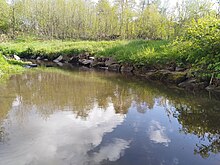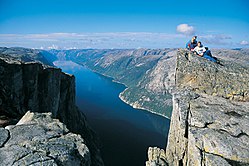
Back Watermassa Afrikaans Gewässer ALS مسطح مائي Arabic مسطح مائى ARZ Һыу объекты Bashkir Ondens telkėnīs BAT-SMG Lawas nin tubig BCL Peraèran BEW Воден басейн Bulgarian जलभंडार Bihari


A body of water or waterbody[1] is any significant accumulation of water on the surface of Earth or another planet. The term most often refers to oceans, seas, and lakes, but it includes smaller pools of water such as ponds, wetlands, or more rarely, puddles. A body of water does not have to be still or contained; rivers, streams, canals, and other geographical features where water moves from one place to another are also considered bodies of water.[2]
Most are naturally occurring geographical features, but some are artificial. There are types that can be either. For example, most reservoirs are created by engineering dams, but some natural lakes are used as reservoirs. Similarly, most harbors are naturally occurring bays, but some harbors have been created through construction.
Bodies of water that are navigable are known as waterways. Some bodies of water collect and move water, such as rivers and streams, and others primarily hold water, such as lakes and oceans.
Bodies of water are affected by gravity, which is what creates the tidal effects.[3] Moreso, the impact of climate change on water is likely to intensify as observed through the rising sea levels, water acidification and flooding. This means that climate change has pressure on water bodies.[4]
Climate change significantly affects bodies of water through rising temperatures, altered precipitation patterns, and sea-level rise. Warmer temperatures lead to the melting of glaciers and polar ice, contributing to rising sea levels and affecting coastal ecosystems. Freshwater bodies, such as rivers and lakes, are experiencing more frequent droughts, affecting water availability for communities and biodiversity. Moreover, ocean acidification, caused by increased carbon dioxide absorption, threatens marine ecosystems like coral reefs.[5] Collaborative global efforts are needed to mitigate these impacts through sustainable water management practices.[6]
- ^ "waterbody noun (pl. -ies) a body of water forming a physiographical feature, for example a sea or a reservoir." New Oxford Dictionary of English
- ^ Langbein, W.B.; Iseri, Kathleen T. (1995). "Hydrologic Definitions: Stream". Manual of Hydrology: Part 1. General Surface-Water Techniques (Water Supply Paper 1541-A). Reston, VA: United States Geological Survey..
- ^ "What causes high tide and low tide? Why are there two tides each day?". HowStuffWorks. 21 May 2009. Retrieved 10 December 2017.
- ^ "European Environment Agency's home page – European Environment Agency". eea.europa.eu. Retrieved 2022-11-03.
- ^ "Ocean acidification | National Oceanic and Atmospheric Administration". noaa.gov. Retrieved 2024-10-28.
- ^ Lee, Hoesung (2023). "Climate Change 2023 Synthesis Report" (PDF). Intergovernmental Panel on Climate Change: 18–19.